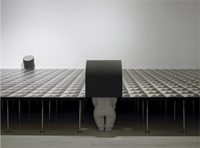June 28, 2007
A Theatre Without Theatre

The Links Between the 'Experience of the Senses' and 'Action'
A Theatre Without Theatre :: until September 11, 2007 :: Museu d'Art Contemporani de Barcelona, Placa dels Angels, 1, 08001 Barcelona :: Curators: Bernard Blistène and Yann Chateigné, with the collaboration of Pedro G. Romero :: Co produced by: Museu d’Art Contemporani de Barcelona (MACBA) and Museo Berardo in Lisbon.
A Theatre Without Theatre explores the metaphors in which the influences of the theatre model made themselves felt in the arts of our times throughout the 20th century. This exhibition brings together more than 800 works, including paintings, sculptures, installations, drawings, photographs, videos, manuscripts and various other types of documents.
The exhibition reflects on the condition of the subject in contemporary society and on the links between the 'experience of the senses' and 'action'. At the same time, it considers the dramatic roots of art as a constituent element of western modernity: from Vsevolod Meyerhold to Oskar Schlemmer, from Antonin Artaud to Judith Malina and Julian Beck (founders of the Living Theatre company), from Samuel Beckett to Tadeusz Kantor, the theatre has been a wellspring of ideas and theories that have been absorbed by art, becoming models of the aesthetic and spatial relationship. Art could, to a certain extent, be 'the other stage' of dramatic practice.
A wide range of approaches to the notion of drama and the points of convergence between an 'archaic' art and aesthetic innovation and the break with the past are presented in various fields of research in this exhibition, which reveals the artists and the themes common to both the theatre and art. The exhibition is not structured to show a pattern of evolution over time but instead centres on various core areas of analysis in which the genealogies and influences from the early 20th century are set out.
The theatre stage is a space isolated from the real world and hence is fictitious (though not false). It is perhaps this separation -- the distance between the actor and the audience member -- that enables the theatre to serve as a critical model as regards the 'apparent' and to use its full weight to facilitate the circulation of ideas. The 20th century was a period when the theatre got caught up in a process of transformation that eventually came to affect the roots of western culture as a whole and art in particular.
From the mid-1960s onwards, the notion of theatricality was a prominent element in contemporary art criticism. Minimalism was initially regarded as harmful and thought likely to destroy art as it had been known till then. Michael Fried, the American critic, railed against it in his famous essay Art and Objecthood (1967) on the grounds that it proposed a relationship between the work and the spectator that could lead the space of the artwork to absorb the viewer. The artists of the generation immediately after Minimalism appropriated the theatre model in order to create a core from which the foundations underpinning the contemporary could extend outwards. These foundations were the simultaneity of action and perception in the arts and the constant swapping of roles between actors and audience.
In the early 20th century, Dada, Futurism and Constructivism clearly expressed the close bond between aesthetic renewal and the theatre model. Cabaret, music hall, soirées or social gatherings, declamation and reading became modes of presenting active art for many artists after 1916. Playwrights such as Antonin Artaud and Samuel Beckett have been regarded as the true founders of artistic approaches and practices that go beyond the mere quotation.
A THEATRE WITHOUT THEATRE begins with the confrontation between the invention of Minimalism --with works by Carl André, Robert Morris and Donald Judd-- and its rejection and refutation by the following generation -Dan Graham, Bruce Naumann, Marcel Broodthaers, James Coleman and Michelangelo Pistoletto-. In the works of these latter artists, it is possible to see the importance of the text and the 'set' and to appreciate the need for a new attitude on the part of the audience, which is sometimes directly addressed and always questioned during the act of perception.
A THEATRE WITHOUT THEATRE is complemented by the research of Pedro G. Romero into the relationship between art and the theatre model in Spain: works by Federico García Lorca, Ramón Gómez de la Serna, Helios Gómez, Antonio Miralda, the Teatro Estudio Lebrijano Company and Ocaña, among others, are featured in the various sections of the exhibition.
Posted by jo at June 28, 2007 11:53 AM
